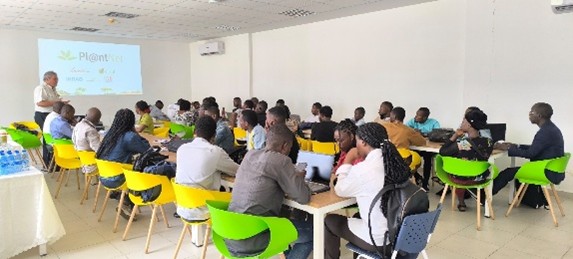

25.04.2025
Do you already have the Pl@ntNet app on your cell phone? This app has been enhanced to identify trees in Central Africa. An upcoming training session will be held in Libreville from May 26 to June 3.

Pl@ntNetis an app for identifying plants from photos. The development of Pl@ntNet in Central Africa was proposed at the One Forest Summit in Libreville in March 2023 and is part of the One Forest Vision Initiative. The objective is
(i) to facilitate plant identification through the sharing of images of well-identified species and the collection of new photographs of formally identified plants, with a particular focus on the initiative's eight super sites
(ii) to involve the community (scientists, teachers, amateurs, and the general public) in a participatory approach.

An agreement has been signed between Pl@ntNet and the University of Liège, and some of the images from the future Guide to the Trees of Central Africa (GAAC) are currently being shared (around 400 species) on the platform. Several botanists based in Cameroonian and Congolese institutions and at the IRD have already shared their datasets on trees and on certain groups or families such as the Annonaceae, Ferns, Orchidaceae, and Rubiaceae.
Three training sessions on the use of the tool have already taken place in Congo (March-April and October-November 2024) and Cameroon (January 2025), enabling the sharing of > 400 species and bringing together more than 220 participants, some of whom are involved in activities in three of the initiative's eight supersites (Bouamir and Mbalmayo in Cameroon and Loundoungou in Congo).
Led by Daniel Barthélémy (Cirad) and Murielle Simo-Droissart (IRD), and co-organized with the National Center for Scientific and Technological Research (CENAREST) and the National Herbarium of Gabon, the first training session on the use of Pl@ntNet in Gabon will take place in Libreville and the surrounding area from May 26 to June 3, 2025. Around 30 participants have already expressed interest and registration is open until May 1. The training will enable participants to enhance their technical skills while integrating modern digital practices into their research or environmental and ecosystem management activities, in floristic and forest inventories, and in teaching and training.
 Crédit photo : Saint Fédriche Ndzaï
Crédit photo : Saint Fédriche Ndzaï
Before the actual start of activities in March 2024, less than 25% of the flora of tropical West-Central Africa was illustrated. Thanks to the network of actors in the subregion and the massive import of images from GBIF, 85% of the species of flora are currently illustrated with at least one image. Trees represent 25% of the flora of Central Africa. Nearly 90% of these are now illustrated on the platform, almost half of them solely by a herbarium scan. Because accurate carbon estimates depend on accurate species identification during inventories, it is important to compile tree observations that will contribute to training the model and subsequently to better recognition of these species.
To this end, observations should include images
(i) of the base of the trunk,
(ii) of the bark before and after cutting,
(iii) of the leaf, if possible fresh, and any other organs (flowers, fruit, etc.) or characteristics that are present at the time.
The offline mode of the mobile app has been updated. It provides a very similar experience to the connected version and allows you to take full advantage of the tool during forest inventories. The activation of geolocation, which is crucial for species mapping, and the sharing of contextual information greatly increase the relevance of the data for biodiversity monitoring. Thanks to your contributions, become an active citizen of the Pl@ntNet project by improving the rapid and accurate identification of plants!